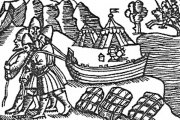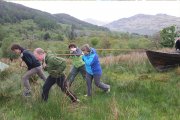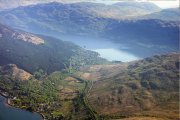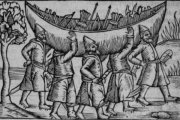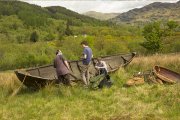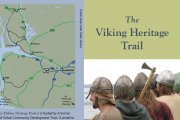Vikings
Loch Long: Loch Long penetrates deep into the mountains, providing easy access from the sea for people wishing to settle or trade, as well as for those with less peaceful intentions. In 1263, followers of the Norwegian King Haco pulled their boats out at Arrochar and across the isthmus to Loch Lomond, from where they sailed south to plunder the settlements around Loch Lomond. The name Tarbet is derived from the gaelic, An Tairbeart, meaning an isthmus.
Largs: Just before the Battle fo Largs, King Haco's fleet was moored in Lamlash Bay, off the coast of Arran. One of his Marshalls, Vieglikr Stallari visited a cave and left his mark in runes saying: "Vigleikr Stallari carved [these runes]". You can see an image of them by clicking here. 'Our' Icelandic saga Haco's expedition against Scotland, A.D. MCCLXIII, by Sturla Þórðarson relates that this same Marshall, Vigleikr, later travelled up Loch Long and travelled across our isthmus to raid Loch Lomond. Another exciting Viking connection between our landscape and the past!
Saga: This portage route was recorded in an Icelandic saga written in the 13th century. Also check out the latest BBC documentary on the Last Battle of the Vikings here.
The Vikings in Strathclyde: The Hidden Heritage project commissioned a report by Dr. Elizabeth Pierce (Glasgow University) to identify any Viking-related archaeological evidence in the area. Thanks to Elizabeth, this excellent report has now been completed, which you are welcome to download: Archaeological and historical evidence for the Vikings in Central and Western Scotland. For a summary of the story and images, please click here. We have developed a leaflet detailing sites around the Clyde with evidence of Viking presence. You can download a copy here.
DNA Evidence: The lands around Arrochar and Tarbet belonged to the MacFarlanes from 1225, when Gilchrist was granted the lands by his father, Alwyn 2nd earl of Lennox, until 1784 when they were sold to Ferguson of Raith. Many MacFarlane descendants are currently taking part in a DNA project to trace their ancestry, and research to date has identified several DNA patterns common amongst Viking raiders and settlers along Scotland's west coast. This suggests that the Norse settlers may have intermarried with local MacFarlane women.
Experimental Archaeology: It's hard to imagine that even Vikings could have dragged their longships across land from Arrochar to Tarbet! In fact, they wouldn't have to - they'd have carried smaller boats on board their longships, and these are what they'd have dragged. These smaller boats might have been very similar to Shetland 'yoals', which are still made today, using techniques very similar to those he Vikings would have used. Volunteers from GalGael brought one of these yoals to Tarbet, and demonstrated, with the help of a few volunteers, that it'd actually be quite easy to drag these across land.
Blog
Click on the link here to check out our Facebook page.
Events
Click here to find out about forthcoming events and how to get involved.
Timeline
Click here to see our timeline of events.
Location
Click here to find out where the Hidden Heritage Project is taking place.
Contact Us
Click here for our contact details.



